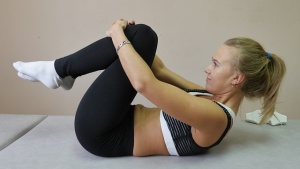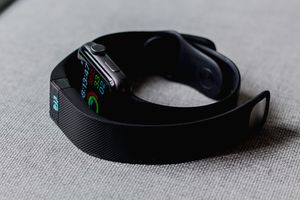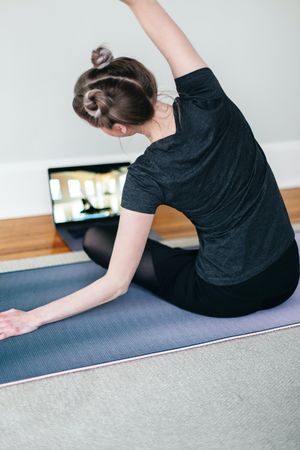Adherence to Home Exercise Programs: Difference between revisions
No edit summary |
No edit summary |
||
| Line 44: | Line 44: | ||
[[File:Exercise home.jpg|right|frameless]] | [[File:Exercise home.jpg|right|frameless]] | ||
* There is minimal available evidence for the effectiveness of current strategies to increase HEP adherence. | * There is minimal available evidence for the effectiveness of current strategies to increase HEP adherence. | ||
* Note that one systematic review has identified strong evidence for computerized technology not being more effective at improving HEP adherence compared to other strategies. | * Note that one systematic review has identified strong evidence for computerized technology not being more effective at improving HEP adherence compared to other strategies. <ref name="Gaikwada">Gaikwada SB, Mukherjee T, Shahb PV, Ambodeb OI, Johnson EG, Dahera NS. Home exercise program adherence strategies in vestibular rehabilitation: a systematic review. Phys Ther Rehabil Sci, 2016, 5(2), 53-62</ref> | ||
'''Patient Education''' | '''Patient Education''' | ||
*Educating patients on pain versus harm by explaining the nature of pain and nociception and suspending the belief that pain is an indicator of further tissue damage <ref name="Jack" /> | *Educating patients on pain versus harm by explaining the nature of pain and nociception and suspending the belief that pain is an indicator of further tissue damage <ref name="Jack" /> | ||
| Line 79: | Line 77: | ||
*Most studies utilize report diaries as a measure of adherence to a home program. Limitations of this measure include poor completion rates, inaccurate recall and self-presentation bias. Measuring adherence can be viewed as an intervention in and of itself as it might result in more patients adhering to their exercise program as they are forced to record it in a diary <ref name="Beinart" /> | *Most studies utilize report diaries as a measure of adherence to a home program. Limitations of this measure include poor completion rates, inaccurate recall and self-presentation bias. Measuring adherence can be viewed as an intervention in and of itself as it might result in more patients adhering to their exercise program as they are forced to record it in a diary <ref name="Beinart" /> | ||
*Other measures that are currently available include: computer programs, phone applications and wearable technology (e.g. pedometers) <ref name="Beinart" /> | *Other measures that are currently available include: computer programs, phone applications and wearable technology (e.g. pedometers) <ref name="Beinart" /> | ||
*Future research is required to develop validated tools to identify patient adherence and barriers to adherence. | |||
*Future research is required to develop validated tools to identify patient adherence and barriers to adherence. | |||
*The following is a sample of tools available to estimate patient adherence <ref>McLean S, Holden M, Haywood K, Potia T, Gee M, Mallett R, Bhanbhro S. Recommendations for exercise adherence measures in musculoskeletal settings: a systematic review and consensus meeting. Project Report. Chartered Society of Physiotherapy. 2014. (Submitted)</ref> <br> | *The following is a sample of tools available to estimate patient adherence <ref>McLean S, Holden M, Haywood K, Potia T, Gee M, Mallett R, Bhanbhro S. Recommendations for exercise adherence measures in musculoskeletal settings: a systematic review and consensus meeting. Project Report. Chartered Society of Physiotherapy. 2014. (Submitted)</ref> <br> | ||
Revision as of 08:11, 19 May 2020
Original Editor - Laura Ritchie, posting on behalf of Yulia Biggar, MPT Class of 2016 at Western University, project for PT9585 Top Contributors - Laura Ritchie, Lucinda hampton, Kim Jackson, Tony Lowe, Candace Goh, Evan Thomas, WikiSysop and Claire Knott
Introduction[edit | edit source]
Adherence to home exercises (HEP) in rehabilitation is a significant problem, and the reasons for this are multifactorial, covering both psychological and situational factors that vary between each individual, and that need to be considered by clinicians in the design of personalized exercise programs[1].
- Providing a home exercise program (HEP) to patients is one of the most fundamental and important aspects of physiotherapy.[2]
- Patients who adhere to their prescribed exercises are significantly better at achieving their goals and demonstrate a greater increase in physical function[3][4][5].
- Patients adhere poorly to their prescribed home program, with varying estimations from research.[6] Non-adherence to a home exercise program has been shown to be as high as 50-65% for general MSK conditions.[7] In the low back pain patient population, non-adherence to home exercise has been shown to be as high as 50-70%.[6]
- Nonadherence of a HEP increases the risk of recurrent injury or flare-ups with less positive outcomes long term[2] and can result in the physiotherapist believing that their current treatment is not effective.[8]
- Overall, there is a need for good quality evidence to identify potential barriers to patient adherence and the strategies that are effective at combating those barriers.
Effect of Number of Home Exercises and Complexity on Compliance and Performance of HEP[edit | edit source]
When setting a HEP remember that the long list you may put together may be all inclusive but research shows [9]
- Subjects who were prescribed 2 exercises performed better than subjects who were prescribed 8 exercises, another report finding those prescribed 4 or more exercises had a lower rate of compliance than those prescribed 2 or fewer[10]
- Subjects who are prescribed 2 exercises will perform better than subjects who are prescribed 8 exercises
- Subjects who are prescribed 2 exercises will comply on their self-report exercise log more than subjects who are prescribed 8 exercises
- Compliance with behavioral treatments (eg, an exercise program) is similar to drug compliance; as complexity increases, compliance decrease (confused man R).
Factors Affecting Adherence[edit | edit source]
- Perceived Barriers - eg forgetting to exercise, not having the time, not fitting into the daily routine, work schedules[1](See image, busy multi tasking at home).
- Self-Efficacy ie an individual’s belief in their own capability to achieve a task that will produce a targeted result.
- Threat and Beliefs ie The beliefs a patient holds regarding their condition and the decisions made by patients are based on their own beliefs, personal experiences, and the information they receive.
- Locus of Control - patients with an external locus of control demonstrate a lesser degree of adherence with HEP.
- Pain - Pain levels during exercise in musculoskeletal patients presented strong evidence as a barrier to adherence in a systematic review.[1]
- Physical Activity - Studies suggest that those who are physically active at baseline demonstrate significantly better adherence to home exercise programs.
- Psychological Symptoms - Depression as a barrier to adherence has strong supporting evidence.[1]
- Social Support - The social support network of the patient has also been suggested as a possible factor in adherence eg friends and family members, as well as support from the therapist.
Health technologies[edit | edit source]
Health technologies, such as the use of mobile devices, including mobile phones and tablets, as well as software apps, provide us with the opportunity to better support the patient and clinician, with a data-driven approach that incorporates features designed to increase adherence to exercise such as coaching, self-monitoring and education, as well as remotely monitor adherence rates more objectively.
Software apps exist on the market and may well change the way of many home exercise plans in clinics. The promise to do such things as " make it easy to build a home exercise program in seconds, with beautifully designed instructional videos. The built-in efficiencies will reduce your workload. Plus, our software motivates your patients and improves outcomes, with tracking tools and insightful analytics." Research is yet to confirm this but many clients like the idea of visualisation and direct feedback[11]
Combining the popularity of mobile devices with the on-going search for fitness, thousands of fitness applications (apps) are available for free or low cost. Apps allow users to set fitness goals, track activity, gather workout ideas, and share progress on social media. Physiotherapists should stay abreast with recent research and follow the guideline as they emerge.
- Those who utilized the apps were more likely to have a positive attitude about the apps.
- Usefulness and perceived difficulties in particular should be considered with future app development.
- App usefulness and ease of use may be facilitated by using health behavior theories to guide development.[12]
Strategies to Increase Home Program Adherence[edit | edit source]
- There is minimal available evidence for the effectiveness of current strategies to increase HEP adherence.
- Note that one systematic review has identified strong evidence for computerized technology not being more effective at improving HEP adherence compared to other strategies. [13]
Patient Education
- Educating patients on pain versus harm by explaining the nature of pain and nociception and suspending the belief that pain is an indicator of further tissue damage [2]
- Reinforcing messages which reduce fear or anxiety about pain [2]
- Emphasizing the idea that exercise will lead to less pain, anxiety, and depression
- Countering maladaptive coping strategies [13]
- Employing motivational techniques such as counseling, positive feedback and outcome measures that will highlight progress in order to increase a patient's self-efficacy [14]
- Managing expectations by educating patients on tissue healing timelines, their prognosis and the importance of their own involvement in their treatment plan [2]
- Providing a cognitive behavioral program aimed to enhance self-efficacy and reduce perception of barriers
- Motivational interviewing to set personal treatment goals [2]
Treatment
- Minimizing pain during a treatment session/home exercise program. Using pain reducing modalities such as heat/ice, TENS/IFC as well as manual therapy techniques may be useful in alleviating pain during treatment. This may encourage patients to keep performing their exercises knowing that their pain will be alleviated [2]
- Utilizing graduated exercise - to reduce anxiety and fear avoidance exercises should be progressed slowly and gradually to increase patients’ confidence in their own physical abilities [2]
- Providing explicit verbal instructions when introducing a new exercise program, checking a patient's ability to recall as well as providing written instructions [2]
- Encouraging patients to keep exercise logs, diaries, logs to track their progress, symptoms, etc [13]
- Reviewing exercise and symptom logs at every treatment [13]
Personalized Approach
- Tailoring exercise program demands to the patient. For example, proposing an extensive cardio and strength program for patients who are inactive at baseline would be ineffective. Instead, patients should be introduced to regular exercise in small steps that they feel confident they can manage [2]
- Participating in Telerehabilitation and Smartphone Apps in Physiotherapy in the form of email support or telephone support [13]
- Providing patients with pictures and videos of themselves performing the prescribed exercises [13]
- Establishing a personalized treatment contract negotiated and agreed upon with the patient [14]
- Referring patients to the appropriate specialist for their depression or anxiety [2]
- Introducing patients to group exercise classes to increase their supportive network and boost their confidence [2]
| [15] | [16] |
Measurements of Home Program Adherence[edit | edit source]
- Most studies utilize report diaries as a measure of adherence to a home program. Limitations of this measure include poor completion rates, inaccurate recall and self-presentation bias. Measuring adherence can be viewed as an intervention in and of itself as it might result in more patients adhering to their exercise program as they are forced to record it in a diary [6]
- Other measures that are currently available include: computer programs, phone applications and wearable technology (e.g. pedometers) [6]
- Future research is required to develop validated tools to identify patient adherence and barriers to adherence.
- The following is a sample of tools available to estimate patient adherence [17]
- Sports Injury Rehabilitation Adherence Scale (SIRAS)- 3-item scale completed by the therapist
- Hopkins Rehabilitation Engagement Rating Scale (HREPS)- 5-item questionnaire completed by the health professional in an acute inpatient setting.
- Adherence to Exercise Scale for Older Patients (AESOP)- patient completed 43-item questionnaire
- The Modified Rehabilitation Adherence Questionnaire (RAQ-M)- 25-item scale to evaluate potential barriers to patient adherence
Barriers to Home Exercise Program Adherence[edit | edit source]
Strong Level of Evidence
- Pain - worsening pain during a treatment session is associated with a barrier to a home exercise program [2]
- Low levels of physical activity at baseline - patients who are not used to following a regular fitness program are less likely to incorporate a physiotherapy exercise program into their schedule [2]
- Low self-efficacy - self-efficacy refers to the patient’s belief that he/she will be successful in a particular situation or in accomplishing a goal. Self-efficacy can be identified by asking: "how confident are you that you can overcome obstacles to exercising?". Patients with low self-efficacy tend to have lower adherence rates
| [18] |
- Anxiety or stress at baseline - strong predictor of poorer outcomes at long term follow-ups [2]
- Depression - lower levels of depression are correlated to a greater motivation to exercising [2]
- High degree of helplessness - patients with higher levels of helplessness (i.e. patients who believe there is no escape from their long-standing pain) tend to exercise less than those with low feelings of helplessness
- Lack of social support - the absence of a strong support network can lead to lower levels of adherence to a HEP [2]
- Enabling by family members - patients with overprotective families that discourage any activity that may cause discomfort are more likely to be less active and less adherent to a HEP [2]
- Barriers to exercise - perceiving greater barriers to exercise is associated with poorer adherence. Such barriers include transportation problems, child care needs, work schedules, lack of time, family dependents, financial constraints, convenience and forgetting [2]
- High levels of neuroticism - neuroticism is a personality trait that is associated with anxiety, fear, worry, envy, frustration, depressed mood and a reduced ability to cope with stressors. High levels of neuroticism were associated with withdrawal from responsibilities and decreased goal achievement [8]
- Therapeutic alliance - patients who perceive a positive relationship with their physiotherapist on factors of productivity, communication and trust are more likely to adhere to their home exercise program [8]
Moderate Level of Evidence
- Health locus of control - there are three factors that contribute to a person’s locus of control:
- Internal - the belief that individuals are responsible for their own outcomes
- Chance - outcomes are a result of luck or chance
- Powerful others - individuals with higher authority are responsible for the individual’s outcomes
Patients with higher levels of an internal locus of control adhere better to home exercise programs. Patients with higher internal locus of control are more likely to report lower levels of pain and to return to work/vocational activities quicker. Patients with lower internal locus of control believe that they have little control over their own situation and have been shown to be less adherent to a HEP [8]
Limited Level of Evidence
- Higher disability level - disability level was evaluated using The Low Back Pain Disability Index, a 10 item questionnaire identifying pain and activity limitations, where higher scores are associated with higher levels of disability. Patients who scored higher on this questionnaire were more likely to adhere to a HEP [6]
- Lower motivation - although motivation is often correlated with treatment outcome, research has so far failed to show a clear relationship between motivation level and adherence to HEP [6]
Conflicting Evidence
- Greater pain at baseline - it is unclear whether greater pain at baseline serves as a motivating factor or a barrier to exercise adherence [2]
- Age - currently there is conflicting evidence on whether older patients tend to adhere more or less to an exercise program than younger patients. Older patients may be generally less mobile than younger patients and may perceive the prescribed exercises as requiring more energy. On the other hand, younger patients have to juggle busy schedules, while older patients may have more time to engage in their HEP [2]
- Low levels of optimism - although low levels of optimism are associated with withdrawal from goal pursuits there is no clear evidence that it results in decreased adherence [8]
Resources[edit | edit source]
This article by Bollen et al (2014) cites 58 studies reporting on 61 measures of self-reported adherence, thus the measures can be determined through using the reference list.
References[edit | edit source]
- ↑ 1.0 1.1 1.2 1.3 Argent R, Daly A, Caulfield B. Patient involvement with home-based exercise programs: can connected health interventions influence adherence?. JMIR mHealth and uHealth. 2018;6(3):e47.Available from: https://www.ncbi.nlm.nih.gov/pmc/articles/PMC5856927/ (last accessed 19.5.2020)
- ↑ 2.00 2.01 2.02 2.03 2.04 2.05 2.06 2.07 2.08 2.09 2.10 2.11 2.12 2.13 2.14 2.15 2.16 2.17 2.18 2.19 2.20 Jack K, McLean SM, Moffett JK, Gardiner E. Barriers to treatment adherence in physiotherapy outpatient clinics: A systematic review. Manual Therapy, 2010, 15: 220–228
- ↑ Di Fabio RP, Mackey G, Holte JB. Disability and functional status in patients with low back pain receiving workers' compensation: a descriptive study with implications for the efficacy of physical therapy. Physical Therapy. 1995 Mar 1;75(3):180-93.
- ↑ Pinto BM, Rabin C, Dunsiger S. Home‐based exercise among cancer survivors: adherence and its predictors. Psycho‐Oncology: Journal of the Psychological, Social and Behavioral Dimensions of Cancer. 2009 Apr;18(4):369-76
- ↑ Karnad P, McLean S. Physiotherapists’ perceptions of patient adherence to home exercises in chronic musculoskeletal rehabilitation. International Journal of Physiotherapy. 2011 Jun;1(2):14-29
- ↑ 6.0 6.1 6.2 6.3 6.4 6.5 Beinart NA, Goodchild CE, Weinman JA, Ayis S, Godfrey EL. Individual and intervention-related factors associated with adherence to home exercise in chronic low back pain: a systematic review. The Spine Journal, 2013, 13:1940–195
- ↑ Bassett SF. The assessment of patient adherence to physiotherapy rehabilitation. NZ J Physiother, 2003, 31: 60–66
- ↑ 8.0 8.1 8.2 8.3 8.4 Wright BJ, Galtieri NJ, Fell M. Non-adherence to prescribed home rehabilitation exercises for musculoskeletal injuries: the role of the patient- practitioner relationship. J Rehabil Med, 2014, 46: 153–158
- ↑ Henry KD, Rosemond C, Eckert LB. Effect of number of home exercises on compliance and performance in adults over 65 years of age. Physical Therapy. 1999 Mar 1;79(3):270-7. Available from:https://academic.oup.com/ptj/article/79/3/270/2837047 (last accessed 19.5.2020)
- ↑ Eckard T, Lopez J, Kaus A, Aden J. Home exercise program compliance of service members in the deployed environment: an observational cohort study. Military medicine. 2015 Feb 1;180(2):186-91. Available from: https://www.ncbi.nlm.nih.gov/pubmed/25643386 (last accessed 19.5.2020)
- ↑ Physioted Physiotherapy exercise app Available from:https://physiotec.ca/au/en/?gclid=CjwKCAjwwYP2BRBGEiwAkoBpAqyXxFghVKgKZXYdlWmnRBwSHtVcXJe8qV_6GI0DnAyGEZtO7EJYiBoCvVIQAvD_BwE (last accessed 18.5.2020)
- ↑ Herrmann LK, Kim J. The fitness of apps: a theory-based examination of mobile fitness app usage over 5 months. Mhealth. 2017;3. Available from:https://www.ncbi.nlm.nih.gov/pmc/articles/PMC5344171/ (last accessed 18.5.2020)
- ↑ 13.0 13.1 13.2 13.3 13.4 13.5 Gaikwada SB, Mukherjee T, Shahb PV, Ambodeb OI, Johnson EG, Dahera NS. Home exercise program adherence strategies in vestibular rehabilitation: a systematic review. Phys Ther Rehabil Sci, 2016, 5(2), 53-62
- ↑ 14.0 14.1 McLean SM, Burton M, Bradley L, Littlewood C. Interventions for enhancing adherence with physiotherapy: A systematic review. Manual Therapy, 2010 15: 514-521
- ↑ TED Talks. Cosmin Mihaiu: Physical therapy is boring — play a game instead. Available from: http://www.youtube.com/watch?v=3_AZ5R2SC88 [last accessed 30/08/2016]
- ↑ ELLICSR: Health, Wellness and Cancer Survivorship Centre. Dr. Paul Ritvo on How Cancer Survivors Adhere to an Exercise Program and Why: WE-Can Program. Available from: http://www.youtube.com/watch?v=ib-nL77WYTs [last accessed 30/08/2016]
- ↑ McLean S, Holden M, Haywood K, Potia T, Gee M, Mallett R, Bhanbhro S. Recommendations for exercise adherence measures in musculoskeletal settings: a systematic review and consensus meeting. Project Report. Chartered Society of Physiotherapy. 2014. (Submitted)
- ↑ Miss Massey. Barriers To Exercise Adherence. Available from: http://www.youtube.com/watch?v=PeqaRuDS0ko [last accessed 30/08/2016]











